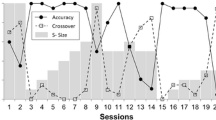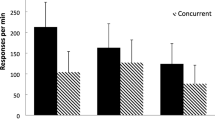Abstract
Perseveration in choice behavior of retardates was defined as failure to match absolute and relative response rates to changes in relative reinforcement rates with concurrent schedules of reinforcement. 4 experiments showed that concurrent performances of retardates varied systematically as a function of type of schedule, schedule value, duration, and symmetry of changeover delays. Relative but not absolute response rates were proportional to relative reinforcement rates with long changeover delays. Increasing the changeover delay punished changeovers and reduced total reinforcement rates. Contrary to prediction, asymmetrical changeover delays disrupted rather than improved matching. The retardate’s response is similar to that of Weiner’s “one-behavior organism” even in concurrent situations by persisting in maladaptive response patterns until net gains or losses of reinforcement are made contingent upon changes in response patterns.
Similar content being viewed by others
References
BAUMEISTER, A., & BUTTERFIELD, E. 1970. Residential facilities for the mentally retarded. Chicago: Aldine.
BIJOU, S. 1966. A functional analysis of retarded development. In N. Ellis (Ed.), International review of research in mental retardation. Vol. 1. New York: Academic. Pp. 1-18.
CATANIA, A. C. 1966. Concurrent operants. In W. K. Honig (Ed.), Operant behavior: Areas of research and application. New York: Appleton-Century-Crofts. Pp. 213–270.
CATANIA, A. C., & CUTTS, D. 1963. Experimental control of superstitious responding in humans. Journal of the Experimental Analysis of Behavior, 6, 203–208.
DENNY, M. R. 1964. Research in learning and performance. In H. Stevens & R. Heber (Eds), Mental retardation. Chicago: University of Chicago Press. Pp. 100–142.
GERJUOY, I., & GERJUOY, H. 1965. Binary choice sequences of retardates, normal children, and college students under random and pattern set instructions. American Journal of Mental Deficiency, 69, 854–859.
GERJUOY, I., & WINTERS, J. 1967. Response preference and choice sequences preferences: I. Regression to alternation. Psychonomic Science, 7, 413–414.
HERRNSTEIN, R. J. 1970. On the law of effect. Journal of the Experimental Analysis of Behavior, 13, 243–266.
KOUNIN, J. 1941. Experimental studies of rigidity in normal and feeble-minded persons. Character Persona, 9, 251–273.
LABOUNTY, C., & REYNOLDS, G. 1973. An analysis of response and time matching to reinforcement in concurrent ratio-interval schedules. Journal of the Experimental Analysis of Behavior, 19, 155–166.
PLISKOFF, S. 1971. Effects of symmetrical and asymmetrical changeover delays on concurrent performances. Journal of the Experimental Analysis of Behavior, 16, 249–256.
POPPEN, R. 1972. Effects of concurrent schedules on human fixed-interval performance. Journal of the Experimental Analysis of Behavior, 18, 119–128.
SANDERS, R. 1969. Concurrent fixed-ratio fixed4nterval performances in adult human subjects. Journal of the Experimental Analysis of Behavior, 12, 601–604.
SCHROEDER, S., & HOLLAND, J. 1969. Reinforcement of eye movement with concurrent schedules. Journal of the Experimental Analysis of Behavior, 12, 897–903.
SHULL, R., & PLISKOFF, S. 1967. Changeover delay and concurrent schedules: Some effects on relative performance measures. Journal of the Experimental Analysis of Behavior, 10, 517–527.
SILBERBERG, A., & FANTINO, E. 1970. Choice, rate of reinforcement, and the changeover delay. Journal of the Experimental Analysis of Behavior, 13, 187–197.
STRIEFEL, S. 1972. Timeout and concurrent fixed-ratio schedules with human subjects. Journal of the Experimental Analysis of Behavior, 17, 213–220.
WEINER, H. 1966. Preference and switching under ratio contingencies with humans. Psychological Reports, 18, 239–246.
WEINER, H. 1970. Human behavioral persistence. The Psychological Record, 20, 445–456.
ZIGLER, E. 1966. Research on personality structure in the retardate. In N. Ellis (Ed.), International review of research in mental retardation. Vol. 1. New York: Academic. Pp. 77–105.
Author information
Authors and Affiliations
Additional information
This research was supported by grants from the N. C. Department of Mental Health, Unc Faculty Research Council, and Grant #Hd-03-110 of the National Institute of Health.
Rights and permissions
About this article
Cite this article
Schroeder, S.R. Perseveration in Concurrent Performances by the Developmentally Retarded. Psychol Rec 25, 51–64 (1975). https://doi.org/10.1007/BF03394289
Published:
Issue Date:
DOI: https://doi.org/10.1007/BF03394289




